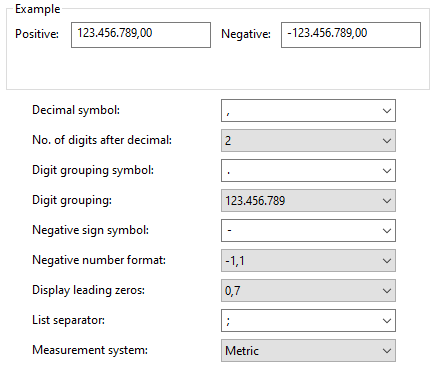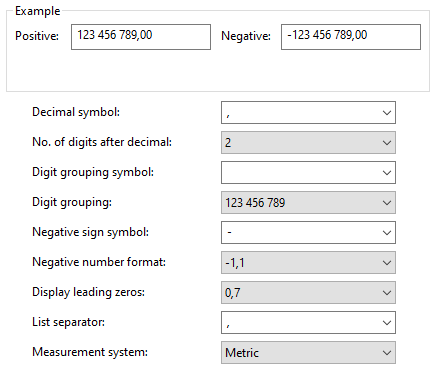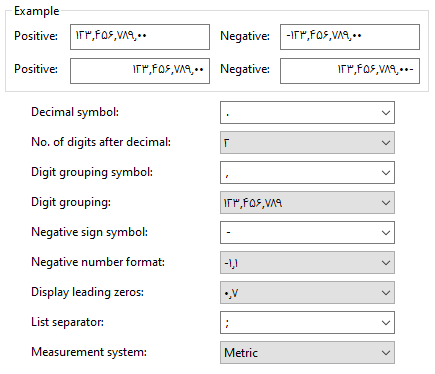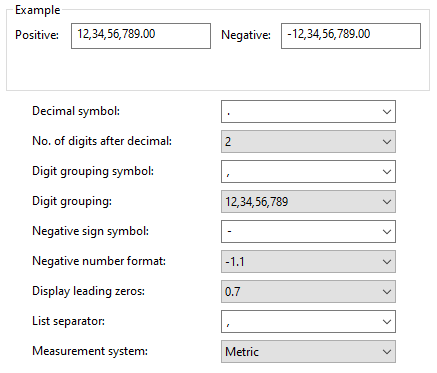I’ll finish this series on place value and writing numbers, with a question that’s not quite as simple as you might think: why we use commas and decimal points as we do. Americans may be surprised at some of the answers – and some of the questions.
Commas are just a convenience
We’ll start with this question from 2001:
Commas in Numbers Why are we taught in grade school to put the comma after the third digit in a large number? (9,876,543,210). Why not the fourth digit? (98,7654,3210). And does the comma really change the number value?
I responded:
Hi, LaToya. The comma has no effect on the value of a number. All it does is make it easier for humans to read it. We put a comma every three digits to match the way we say numbers in English, by thousands. Your number reads naturally as 9 billion, 876 million, 543 thousand, 210 Divided every four digits, you would want to read it as something like 98 myrion, 7654 myriad, 3210 (I made up the word "myrion," but "myriad" really does mean "ten thousand".) The commas are purely for convenience.
So if we used different names for large numbers, we would likely place commas differently. and if we placed the commas differently, we might have different words to use. Hold on to that thought!
If “myrion” existed, it would mean a hundred million.
Commas aren’t universal
A couple months earlier we had this very similar question:
Why Commas after Every Three Places? Why do we put commas after every three places in a number like 200,000? Thank you.
Doctor Floor (that’s his first name) answered, from a very different perspective than mine. But he started out the same:
Hi, Larry, Thanks for writing. The use of commas in large numbers is not necessary, it is a service to the reader. The commas are exactly in the right places to show thousands, millions, billions, trillions, etc., so they fit the way we pronounce the numbers. Also, it is quite comfortable to read numbers in parts of three digits, when you have to "spell" them.
Again, the commas agree with the language; and if there were more digits per group, they would be more awkward to work with. But:
Commas are not used everywhere in the world to do this job. It can be done by using spaces as well, so instead of
3,978,654,128
one sometimes sees
3 978 654 128
In my home country, the Netherlands, the roles of dot and comma are reversed, so here we would write:
3.978.654.128
and the decimal number 3.978 is written as 3,978 in the Netherlands. Be careful when you are outside your own country!
So what we write as 12,345.78 in America would be 12.345,78 in many places. And, yes, this does sometimes cause a little confusion when we get a question about, say, 1,234 from another country, and it turns out to be a decimal!
The decimal point varies, too
The obvious next question is, “Why?” This is from 2007, referring to the decimal point vs. decimal comma (or, more generally, decimal separator or “separatrix”):
Commas and Decimal Points in Currency Notations Why do the Eurolanders use the comma in currency instead of the decimal point as in the States?
This is not only in writing about money, of course. I answered:
Hi, Katherine. During the 1600's there were many competing notations for decimals, of which the comma and period were the two winners. Here's what Cajori, in A History of Mathematical Notations, says about one point in the conflict (p. 328): In the eighteenth century, trials of strength between the comma and the dot as the separatrix were complicated by the fact that Leibniz had proposed the dot as the symbol of multiplication .... As a symbol for multiplication the dot was seldom used in England during the eighteenth century, Oughtred's X being generally preferred. For this reason, the dot as a separatrix enjoyed an advantage in England during the eighteenth century which it did not enjoy on the continent. In the end, the comma won on the continent of Europe; the dot was used in England, though commonly raised rather than on the line (with the low dot used for multiplication). In America the usage varied at first, but has settled down to the low dot for the decimal separator, and a raised dot for multiplication.
So in England at that time, “×” (and later “.”) was used for multiplication and “·” for the decimal separator; while on the continent, “·” was used for multiplication and “,” for the decimal separator. In America, we ended up with “·” (or “×” at the elementary level) and “.” respectively, the reverse of the British usage. And this is the simplified version!
More about decimal separators
The next question is from 2003 (before I wrote the answer above – I had probably forgotten it):
Writing Commas in Numbers Is it true that in France where we in America use decimals in math, they use commas, and where we use commas they use decimals? An example would be we would write 3,998.60 and they would instead write 3.998,60.
I answered:
Hi, Megan. Yes, this is true of much of the non-English-speaking world. I have long wanted to find a good reference that would show me where each convention is used; one that you might find interesting is the Regional and Languages Options box in Windows XP (other versions of Windows may do it differently), where you can select from a long list of countries and see the default choices they give for writing numbers, currency, times, and dates. I don't know whether I always trust Microsoft to know the correct way to use any language, but the variety of options is fascinating! Try picking any European or South American country.
Here is what my current Windows 10 computer shows under Region > Additional Settings when I select Dutch (Netherlands) as for Doctor Floor:

We see the comma for the “decimal symbol”, and dot for “digit grouping symbol”. Here is English (Sweden):

There they use a space for digit grouping.
Now, we would just look it up in Wikipedia, here!
Here are some references I have found that tell a little more about it: Commas in Numbers - Grammar Slammer, English Plus http://englishplus.com/grammar/00000087.htm Many European countries use a comma in place of the decimal point and use periods or blank spaces to separate every third digit. United States: 2,367.48 francs France: 2.367,48 francs or 2 367,48 francs
This agrees with what we heard. (That link still works; those that follow have been redirected to archive.org.)
Cross Cultural Comparisons: Numbers http://www.geocities.com/Broadway/1906/cultr14.html France: The decimal point is a comma, as in all of Europe. Certainly not a dot, except on computers.
Technology sometimes forces a convention on people (e.g. calculators with “.” on a button, even when they’d naturally use a comma).
The following is a favorite site of mine, which I hadn’t realized until now had gone away (but see here):
How Many: Using Numbers and Units - Russ Rowlett http://www.unc.edu/~rowlett/units/numbers.html In English-speaking countries, the decimal point (decimal marker) is the period. In continental Europe and most other places, the decimal marker is the comma. ... Since the comma often means a decimal point, the International System (SI) requires that large numbers, like the billions above, be represented as groups of three digits separated by narrow spaces, not by commas.
Since SI is meant to be international, they have to standardize as much as possible. So they allow either comma or dot for the decimal separator, but spaces for thousands, so that there is never a possibility of confusion.
Then there are technical specifications for “regionalization” of software, much as we saw in Windows settings:
Country-Specific Data Formats http://w3.pppl.gov/misc/motif/MotifStyleGuide/en_US/Country-Specific_Data_Formats.html Thousands Separators The comma, period, space, and apostrophe are examples of valid separators for units of thousands as shown in the following examples: 1 234 567 1.234.567 1'234'567 1,234,567 Decimal Separators The period, comma, and the center dot are examples of valid separators for decimal fractions as shown in the following examples: 5,324 5.324 5·324
After those quotations, I added:
Incidentally, in some countries (such as in India) digits are not even grouped in threes as we do, because they have different traditional names in their languages from our "thousand" and "million." They call 1,00,000 a lakh and 1,00,00,000 a crore. So the way we write numbers is not at all standard around the world.
We’ll see more on India soon.
Why divide digits into threes?
Getting back to commas, why do we use the grouping we do? This is from 2003:
Placement of Commas in Writing Numbers Why is the ones period named for the ones place value and why is the thousands period named for the thousands place? Why is there not a hundreds period?
If you’re unfamiliar with this use of the word “period”, it refers to each set of three digits separated by commas. In the “short word form” we’ve seen, “x millions, y thousands, z ones”, the x, y, and z are the periods, while “millions”, “thousands”, and “ones” are their names. In effect, they are the “digits” in a “base 1000” number.
I answered again:
Hi, Beth. We do, of course, have a PLACE for hundreds; but PERIODS are divided by thousands, to match the way we say numbers aloud: 123,456,789 = 123 million, 456 thousand, 789 [units] So each period is named for the value of its least significant digit, and each period contains three digits. There is no real mathematical reason for doing this, apart from the value of consistency; it is just a good match with English (and most other languages).
If there is a mathematical reason, it’s as I said above, that we are working in “base 1000”, which provides a consistent format, a useful regularity.
You may be interested in the fact that in India, commas are put in irregularly, to match an irregular set of number names:
Numbers in Hindi and Urdu
http://mathforum.org/library/drmath/view/57179.html
In their language, a lakh is what we call one hundred thousand (100,000), and a crore is our ten million (10,000,000). In order to match how they say numbers, they write a lakh as 1,00,000, and a crore as 1,00,00,000.
We’ll be looking at that page in a moment. For the moment, notice that this is irregular, so its only value is to match the words they use, rather than anything mathematical.
So, since we read numbers as "XXX thousand, Y hundred, ZZ", we could very well have chosen to write numbers as XXX,Y,ZZ. But I think it's good that we don't, because it would be confusing, and would not help much if any. Perhaps we were saved from that by the fact that we don't normally put a comma after "hundred" when we write out numbers (or a pause when we read them), so the comma did not seem necessary. Also, the fact that we say "hundred" within the other periods would force us to write X,XX,Y,ZZ, and we just don't need that many commas.
This is an interesting thought. It is ultimately only the desire for regularity, and the fact that we think of “x hundred yty-z” as a single number, that saves us from writing 1,23,4,56 for “one hundred, twenty-three thousand, four hundred, fifty-six”. Those extra commas would mess things up a little.
Lakhs and crores
Here is the question I referred to about India, from 2000:
Numbers in Hindi and Urdu How many crores make one billion?
Doctor Rick took this:
I had never heard of a crore, but I did a simple Web search on the word crore, and I found this, which looks like just what you need: Numbers in Hindi and Urdu - About.com, Inc. http://hindiurdu.about.com/aboutuk/hindiurdu/library/weekly/aa051900a.htm I quote a bit: There are two terms in particular that are worth discussing: lakh and crore. A lakh is one hundred thousand (100,000), a crore is ten million (10,000,000). The South Asian numbering system progresses as follows: ten (das), hundred (sau), thousand (hejar in Hindi, hezar in Urdu), one hundred thousand (lakh) and ten million (crore). Commas are usually placed to show the number of lakhs and crores, so one lakh is written 1,00,000 and one crore is written 1,00,00,000. The structure of the numbering system affects usage. In English "half a million" and "five hundred thousand" are essentially interchangeable. In Hindi and Urdu, the only possibility is "five lakhs". India's population recently reached one billion, but South Asian papers reported this as "one hundred crore".
This quotation directly answers the question about a billion: 1,000,000,000 to us is 100,00,00,000 to them. Their (non-periodic) “periods” are the hejars, lakhs, and crores.
Interestingly, Windows does not show lakh-and-crore commas (by default) for Urdu; in Pakistan it shows essentially American style, and in India it shows the same but with Arabic digits (and either left-to-right or right-to-left):

Here is Hindi:

In 2003 I added this (in my response to a reader who pointed out a small error in the quote above, which has been corrected):
For another reference, see: How Many? A Dictionary of Units - Russ Rowlett http://www.unc.edu/~rowlett/units/ lakh or lac a traditional unit of quantity in India, equal to 10^5 or 100 000. In India the lakh is used commonly instead of the million and commas are used to isolate the number of lakh; for example, the number 5 300 000 is called 53 lakh and written "53,00,000". See also crore. crore a traditional unit of quantity in India, equal to 10^7 or 10 million. Large numbers are usually described in India using the crore and the lakh (10^5); for example, the number 25 600 000 is called 2 crore 56 lakh and written "2,56,00,000".
Note how confusing it would be to read this in their terms if the commas were put in our places! Of course, if they wrote numbers their way in a question written in English, we would wonder whether there were a typo.
Math is not a universal language!
When in India …
Let’s look at two quick questions about lakhs and crores that were not archived. First, from 2006:
How would you read RS1452000 in India?
Doctor Camilo answered:
Hello, Nancy.
That amount, Rs. 14,52,000, would be read as fourteen lakh, fifty-two thousand rupees.
In Indian counting:
1,000 = one thousand
10,000 = ten thousand
1,00,000 = one lakh
10,00,000 = ten lakh
1,00,00,000 = one crore
Note that the commas in Indian counting are in different places from where they would be in the counting of many other countries.
1,000,000 (one million) equals 10,00,000 (ten lakh)
Finally, from 2014:
I am from Nepal where we write the numerical value such as 1,00,000 and call it "lakh". While writing a numerical value, we use comma after 3rd digit and after that every 2nd digit. I would like to know, is this method of expressing numerical value wrong according to international standards. Should I write one lakh as 100,000 or our style of writing is okay. I am confused whether to follow the American style of expressing numerical values and putting comma after every 3rd digit or my style is also okay. One of my Thai friends told me that my style of writing is very wrong.
I answered:
Hi, Nitin. This is not a matter of mathematics, so much as it is a matter of language. You write a number so that it can be easily read in the language of the reader. In English, and many other languages, we have special words for 1,000 (thousand), 1,000,000 (million), and so on, so using commas to mark those makes sense. In your language (or culture) you have names for other quantities, so you naturally mark them as you read them. For international use, it is probably best not to depend on your own local language. The SI specifies using spaces, not commas, and putting them in every third place: http://www.bipm.org/en/publications/si-brochure/section5-3-4.html [current version: section 5.4.4, p. 150] So one lakh would be written as 100 000 and a crore would be 10 000 000
On one hand, Nitin should not be ashamed of his own culture! But on the other, when writing for international use, we need international standards. I have to admit that I might find it awkward to have to use a different style than I was taught, in order to communicate with colleagues in other countries, as if that made America a second-class country; I would have to think of it as adapting to others. But the same is true of using spaces instead of commas (as the SI specifies, as we saw above), or of using the metric system rather than feet and inches for use in international markets.

Pingback: Multiplication, Division, and Powers of Ten – The Math Doctors
Thanks for this! I found it most helpful.